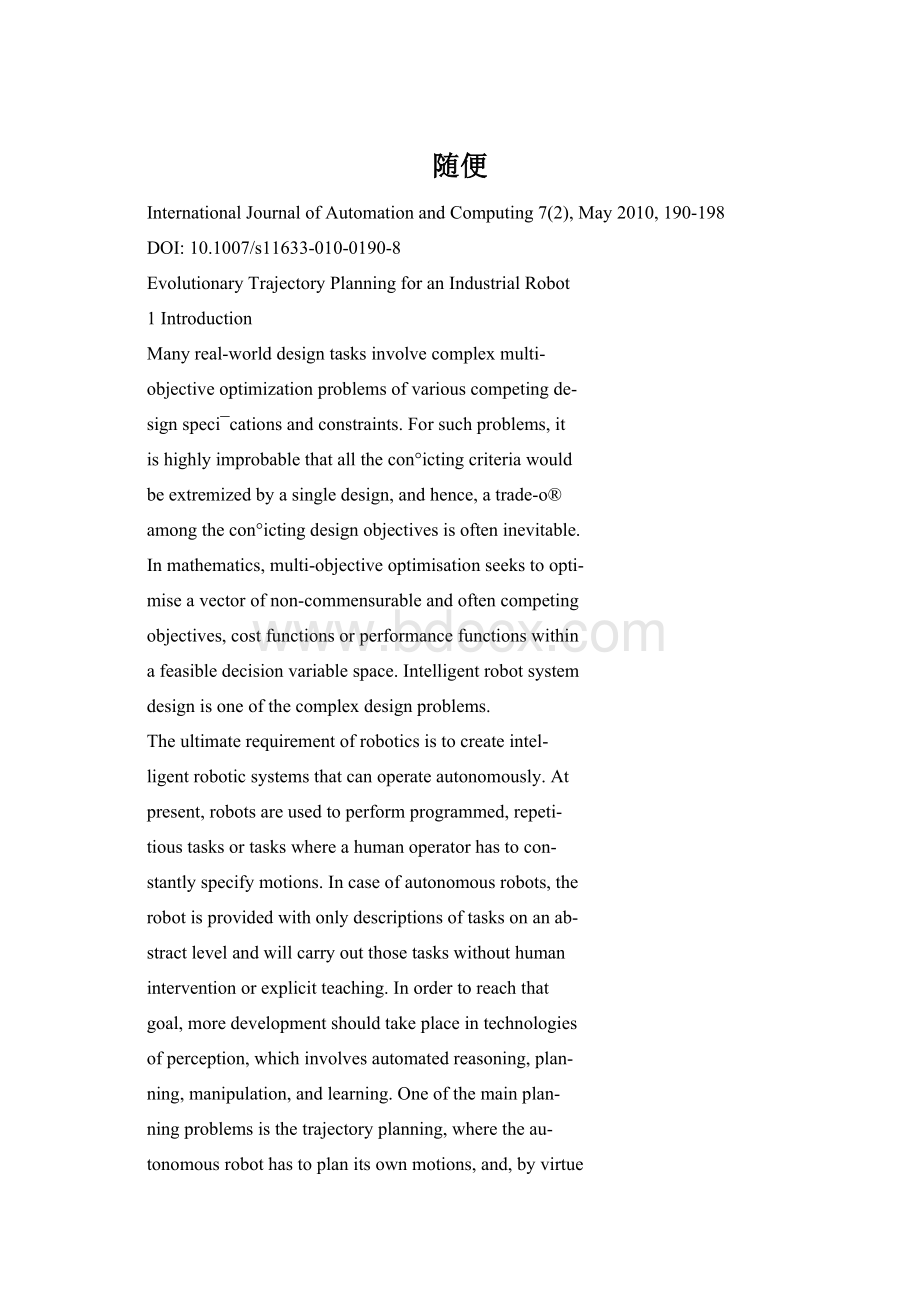随便.docx
《随便.docx》由会员分享,可在线阅读,更多相关《随便.docx(24页珍藏版)》请在冰豆网上搜索。

随便
InternationalJournalofAutomationandComputing7
(2),May2010,190-198
DOI:
10.1007/s11633-010-0190-8
EvolutionaryTrajectoryPlanningforanIndustrialRobot
1Introduction
Manyreal-worlddesigntasksinvolvecomplexmulti-
objectiveoptimizationproblemsofvariouscompetingde-
signspeci¯cationsandconstraints.Forsuchproblems,it
ishighlyimprobablethatallthecon°ictingcriteriawould
beextremizedbyasingledesign,andhence,atrade-o®
amongthecon°ictingdesignobjectivesisofteninevitable.
Inmathematics,multi-objectiveoptimisationseekstoopti-
miseavectorofnon-commensurableandoftencompeting
objectives,costfunctionsorperformancefunctionswithin
afeasibledecisionvariablespace.Intelligentrobotsystem
designisoneofthecomplexdesignproblems.
Theultimaterequirementofroboticsistocreateintel-
ligentroboticsystemsthatcanoperateautonomously.At
present,robotsareusedtoperformprogrammed,repeti-
tioustasksortaskswhereahumanoperatorhastocon-
stantlyspecifymotions.Incaseofautonomousrobots,the
robotisprovidedwithonlydescriptionsoftasksonanab-
stractlevelandwillcarryoutthosetaskswithouthuman
interventionorexplicitteaching.Inordertoreachthat
goal,moredevelopmentshouldtakeplaceintechnologies
ofperception,whichinvolvesautomatedreasoning,plan-
ning,manipulation,andlearning.Oneofthemainplan-
ningproblemsisthetrajectoryplanning,wheretheau-
tonomousrobothastoplanitsownmotions,and,byvirtue
ofthismotion,onlytherobotaccomplishesitstasks.The
classictrajectory-planningproblemisdescribedasfollows:
givenaninitialcon¯gurationanda¯nalcon¯gurationof
therobot,ithasto¯ndapathconnectingbothcon¯gura-
tionsthatavoidscollisionwithobstacles.Assumptionsare
thatthegeometryandthepositionofobstaclesareknown
inadvance,andobstaclesarestationary.
Inordertomaximizespeedofoperation,whicha®ects
theproductivityinindustrialsituations,itisnecessaryto
minimizethetotaltravellingtimeoftherobot.Therefore,
ManuscriptreceivedJune17,2008;revisedJuly10,2009
moreresearchworkshavebeencarriedouttogetminimum
timetrajectories[1¡4].
Therobottrajectoryplanningusingenergeticcriteria
providesseveraladvantages.Ityieldssmoothtrajectories
foreasiertrackingandreducesthestressestotheactuators
andtothemanipulatorstructure.Moreover,savingenergy
maybedesirableinseveralapplications,suchasthosewith
alimitedcapacityofenergysource(e.g.,robotsforspace
orunderwaterexploration).Examplesofenergyoptimal
trajectoryplanningareprovidedinsomeliteratures.Both
optimaltravellingtimeandminimummechanicalenergyof
theactuatorsareconsideredtogetherasobjectivefunctions
insomeliteratures[5;6].
Fieldsofresearchsuchascomputergraphics,geomet-
ricdesign,androbotics(motionplanning)prefersmooth
trajectories,whichareachievedbyminimizingthejoints
jerk[7;8]andjointsacceleration[9].Gasparettoetal.[7;8]
consideredonlykinematicconstraints.Theydidnotcon-
siderdynamicconstraintssuchasjointtorques.Thecon-
ventionalmethod(numericaliterativeprocedure)usedby
ElnagerandHussein[9]cannotbeusedformulti-objective
problems.
Toobtainapracticaltrajectory(suchthattherobotdoes
notlooseanydegreeoffreedomatanystage),themanipula-
bilitymeasurecanbeusedasthedecisioncriteriaforrobot
trajectoryplanning[10;11].Soinordertogetalltheabove
bene¯ts,alltheobjectivefunctionshavetobeconsideredin
acombinedmannertodooptimaltrajectoryplanning.But
noneofliteraturesconsideredalltheseobjectivefunctions
inacombinedmanner.
Manyauthorshavetreatedtheproblemoftrajectory
planningofrobotmanipulatorsinthepresenceof¯xed
obstacles[1;12].Whenmovingobstaclessharethesame
workspaceoccupiedbytherobotmanipulator,theopti-
misationofthetrajectoryde¯nedbytheend-e®ectoris
complex[1;5;6].Thiscomplexityisassociatedwiththelarge
numberofconstraintstobetakenintoaccountbytheop-
R.Saravananetal./EvolutionaryTrajectoryPlanningforanIndustrialRobot191
timiser.Theseconstraintsaretimedependentinthiscase.
Adesignmethodologyusingsequentialunconstrainedmin-
imisationtechniquesisproposedbySaramagoandJunior[5]
toobtaintheoptimalo®-linetrajectoryplanningofrobot
manipulators,whenoscillatingobstacleshavetobeavoided
bytheend-e®ector.Theirproblemofoptimaltrajec-
toryplanningconcernswiththedeterminationoftheend-
e®ectorrobotmotioninaminimumtimeandminimum
mechanicalenergybetweentwogivenpoints,whilesatisfy-
ingthelimitsoftheactuatore®ortsandavoidingcollision
withoscillatingand¯xedobstacles.
Themethodsthatareusedintheliteratures[1¡3;5;6;9¡14]
totacklethecomplexinstances(oscillatingobstaclesenvi-
ronment)havesomenotabledrawbacks:
1)theymayfailto
¯ndtheoptimalpath(orspendalotoftimeandmemory
storage);and2)theyhavelimitedcapabilitieswhenhan-
dlingcaseswheretheconstraintsofmaximumacceleration
andmaximumdecelerationalongthesolutioncurveareno
longermet,orwheresingularpointsorcriticalpointsof
robotcon¯gurationexist.Toovercometheabovedraw-
backs,evolutionaryalgorithmscanbeused.Theadvan-
tagesofevolutionarytechniquesarefollows:
1)theyare
population-basedsearchalgorithms,soglobaloptimalsolu-
tionispossible;2)theydonotneedanyauxiliaryinforma-
tionlikegradients,derivatives,etc;3)theycansolvecom-
plexandmultimodalproblemsforglobaloptimality;and4)
theyareproblemindependent,i.e.,suitableforalltypesof
problems.Evolutionarytechniquesformulti-objectiveop-
timisationarecurrentlygainingsigni¯cantattentionfrom
researchersinvarious¯eldsduetotheire®ectivenessandro-
bustnessinsearchingforasetoftrade-o®solutions.Unlike
conventionalmethodsthataggregatemultipleattributesto
formacompositescalarobjectivefunction,evolutionary
algorithmswithmodi¯edreproductionschemesformulti-
objectiveoptimisationarecapableoftreatingeachobjective
componentseparatelyandleadthesearchindiscoveringthe
besttrade-o®solutions.
Themotivationsforusingpopulation-basedsearchtech-
niquesareasfollows:
1)The¯nalsolutionobtainedfromaconventionalmath-
ematicaloptimizationtechniqueisalwaysdependentonthe
input(i.e.,initialsolution).Thewrongselectionofinitial
solutionmayleadtolocaloptimalsolution.Butincase
ofpopulation-basedtechniques,the¯nalsolutionwillnot
dependontheinitialsolution.So,the¯nalsolutionmay
beaglobaloptimalsolution.
2)Population-basedsearchtechniques(e.g.,evolution-
aryalgorithms(EAs))givemultidirectionalsearch.They
dealsimultaneouslywithasetofpossiblesolutions(theso-
calledpopulation).Thisallowsusto¯ndseveralpossible
solutionsinasinglerunofthealgorithm,insteadofper-
formingaseriesofseparaterunsasinthecaseoftraditional
mathematicalprogrammingtechniques.
3)Optimizingalltheobjectivessimultaneouslyandgen-
eratingasetofalternativesolutionso®ersmore°exibility
todecisionmakers.Thesimultaneousoptimizationcan¯t
nicelywithpopulation-basedapproachessuchasEAsbe-
causetheygeneratemultiplesolutionsinasinglerun.
4)Whencomparedtoconventionalandmathematical
techniquesavailableinliterature[1¡12],evolutionaryalgo-
rithmsconvergequicklyandgivemorenumberofPareto
optimalsolutions.
5)Computationale±ciencyofevolutionaryalgorithms
isbetterthanthoseoftheconventionalandmathematical
techniquesavailableinliterature[1¡12].
6)Signi¯cantcomputationalspeed-upcouldbeachieved,
becausetheirrunningtimeisshorterthanthoseof
conventionalandmathematicaltechniquesavailablein
literature[1¡12].
Intelligentoptimizationalgorithmssuchasnon-
dominatedsortinggeneticalgorithm(NSGA-II)andmulti-
objectivedi®erentialevolution(MODE)areverymuch
desirablefortrajectoryplanningofanintelligentrealworld
robot.Trajectoryplanningforarealworldrobotisavery
complexandtedioustask,duetothefollowingreasons:
1)Theplanningalgorithmhastoconsiderthedynamic
modeloftherobot,whichisdependingontravellingtime,
payload,androbot0stask.Sotheplanningalgorithmisa
time-dependentone.
2)Inrobot0sworkspace,alltypesofobstacles(¯xed,
moving,andoscillatingobstacles)maybepresent.This
callsfortheplanningalgorithmtoconsideralltypesofob-
staclesforobstacleavoidance.Further,theinformation
abouttheobstaclesmaybepartiallyorfullyunknown.
Therefore,checkingforthepresenceofobstaclescollision
withrobotisaverycomplexandtimedependenttask.
3)Theenvironmentaroundtherobotisanever-changing
one.Thiscallsforplanningalgorithmtoupdatethedetails
fortrajectoryplanningforeachtimeinstant.
Thispaperconsidersallthedecisioncriteriafortheop-
timaltrajectoryplanningofindustrialrobotmanipulators
andtheobstacleavoidancecriteriaforoscillatingobstacles.
Inthispaper,twoevolutionaryalgorithms,namely,NSGA-
IIandMODE,areproposedtoobtainoptimaltrajectory
planningforanindustrialrobot(AdeptOneXLrobot).
Twomethods,namelynormalizedweightingobjectivefunc-
tionsandaverage¯tnessfactor,areusedtoselectthebest
solutiontradeo®s.Twomulti-objectiveperformancemea-
sures,namelysolutionspreadmeasureandratioofnon-
dominatedindividuals,areusedtoevaluatetheParetoop-
timalfronts.Twomulti-objectiveperformancemeasures,